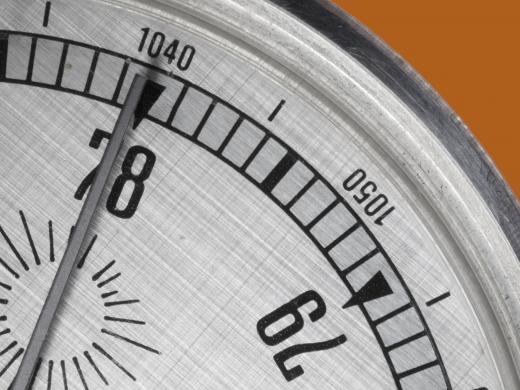What Are the Different Methods of Air Pressure Measurement?
Air pressure, also called atmospheric pressure or barometric pressure, is the amount of weight or force that the atmosphere exerts at any given time on a defined part of the Earth. The primary means of air pressure measurement is using an instrument called a barometer, which is the origin of the term barometric pressure. Mercury or water barometers consist of a hollow tube attached at one end to a container of mercury or water. Air pressure forces the material up into the tube, yielding an air pressure measurement. Meteorologists often use an aneroid barometer, which uses the contraction and expansion of a metal cell to measure atmospheric pressure.
As the amount of air in the Earth’s atmosphere decreases at increasing elevation, an air pressure measurement at sea level will be higher than one taken at a greater height and lower than one from a lesser height. At sea level, which is an elevation of zero, the amount of air pressure is enough to raise the level of mercury in a barometer approximately 30 inches (76.2 cm). Increasing pressure on the mercury will cause it to rise approximately 1 inch (2.54 cm) for every additional 1,000 foot (304.8 m) increase in elevation. An area of high pressure is defined as an air pressure measurement above that at sea level, while low air pressure is a measurement below that at sea level.

An aneroid barometer is an electronic device that also can be used for air pressure measurement. Unlike the mercury barometer, aneroid barometers contain an airless metal chamber that expands or contracts when the air pressure changes. These pulses in the metal are converted to digital signals that provide an output reading of air pressure. Aneroid barometers are often used in home weather prediction devices, which use air pressure changes combined with other atmospheric information.

Meteorologists use barometers to predict changes in the Earth’s atmospheric pressure. This information can be used to create maps of a given country or region that show areas of high and low pressure, as well as areas where air flow is causing atmospheric changes. This data, combined with other information such as air temperature, wind speed, and humidity, is the primary means of predicting thunderstorms, tornadoes, and other severe weather patterns. A rapidly decreasing air pressure measurement can be a predictor of strong winds, because wind is created by air molecules that continually move from areas of high to low pressure in attempt to equalize.
AS FEATURED ON:
AS FEATURED ON:













Discuss this Article
Post your comments